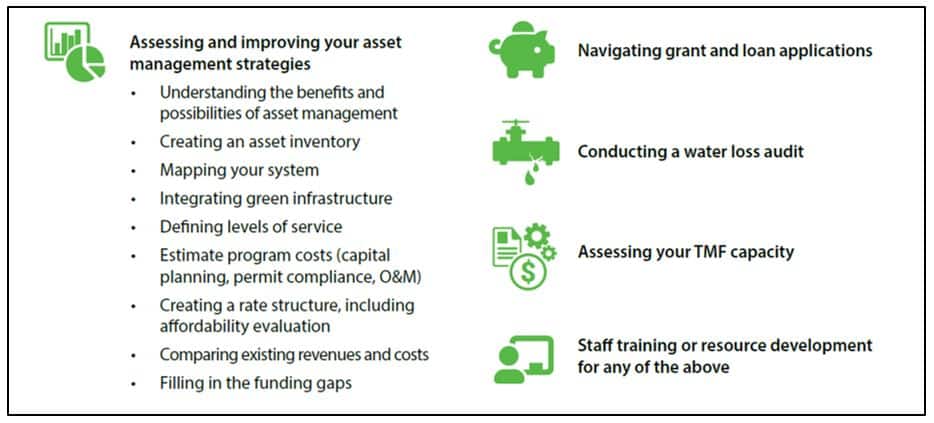“Our water and sewer infrastructure is aging out.”
“Deteriorating infrastructure with capacity that no longer meets demand.”
“Looking for info to help change city water policy on deposit vs. connection fee for account holders.”
So many needs. So little time. Such is the case for many operators and managers of small or underserved wastewater systems. Maybe that’s you—if so, we should talk.
Hi. I’m a technical assistance (TA) provider from the Environmental Finance Center at California State University, Sacramento. Our EFC is funded by the US Environmental Protection Agency (EPA) to provide free services and support to small or disadvantaged communities to improve the technical, managerial, and financial aspects of their drinking water, wastewater programs, and even stormwater. And, if I can’t help you, I will find someone who can.
Want to learn more? Just shoot me an email (maureen.kerner@owp.csus.edu), or fill out a Technical Assistance (TA) request form.
A public works director (PWD) from a small community in Arizona did. He heard about us from discussions with staff at Arizona’s Department of Environmental Quality. Did you know that state regulatory agencies, including the EPA, have programs to help small water systems come into compliance, and operate sustainably in the long term? They all do. Check it out. Anyway, the PWD’s inquiry was as follows:
“Our water and sewer infrastructure is aging out. The majority of our sewer main lines are clay tile with cracked/broken joints, and many manholes are stacked stones, and stacked blocks. Much of our water distribution system is Asbestos Cement (transite), and galvanized steel, with many lines undersized. We can use Technical Assistance in most areas you are promoting. If possible, we need to get the high-priority water and sewer projects into resource development while simultaneously working on the TMF.”
My response: (via email) “Thanks for reaching out. There are lots of opportunities for TA, some now but many more coming…It would be good to discuss your needs to better understand them and find a fit for support…Here’s some availability.”
That’s typically how it starts. A simple email exchange. Then a call that lasts maybe a half hour. I set up the call based on the PWD’s availability, and for this case, invited folks I’ve met from Arizona and the EPA who manage infrastructure funding for water and wastewater projects. During the call, we did introductions and I summarized what I understood to be the system’s prioritized needs while the PWD and other system representatives provided clarity. Then the Arizona coordinator explained the funding opportunities and the process to all of us. She followed up with an email, which reiterated the information that was provided verbally, as well as additional details, resources, and application materials. Since then, she has continued to work with the system representatives to pursue the funding.
Several operators and managers from wastewater systems in Arizona and other Western states have reached out looking for help in starting asset management programs. I sent them our recently released Fiscal Sustainability Plan/Asset Management Plan tool and template, which is accessible through our asset management webpage along with many other asset management resources. We also shared an asset management Info Hub from the Environmental Finance Center Network.
Maybe your needs are more personal. For example, a homeowner in Hawai’i reached out with what she felt was a random question:
…I live in Hawai’i and we have to convert our cesspool to septic by 2050. It is going to be very expensive and quite honestly, I have absolutely no idea where to start. I’ve googled companies and started writing emails hoping to find out things like, whether there is a cheaper time of year (we can save up and then just be their ‘when someone cancels’ house) and/or what it could end up costing realistically, but I don’t know anything about this field at all. I don’t know what I would be looking for in a septic tank and/or a timeline—basically, I have no idea how to not get totally scammed and also have no idea how to pay for it. In an article I read this morning, it said that the EFC has the ability to connect people to resources when it comes to environmental changes like this one, that are required. Figured I would send this message here accordingly. If you have no idea where the request is coming from/how to assist, no stress at all. Just thought I would ask.
Not random at all. We were actually just working on a project with staff from the Hawai’i Department of Health, County of Kaua’i, and the EPA to get funding to homeowners for cesspool replacements through Hawai’i’s Clean Water State Revolving Fund. The funding will become available statewide in the coming years. We were able to do some additional sleuthing, inform the homeowner, and provide her with resources for where she can track the status of the upcoming funding opportunity.
Not sure where to start because you have some many needs? Just throw something out there. Technical Assistance providers like me will help walk you through the rest. We are all here to help. We should talk.


